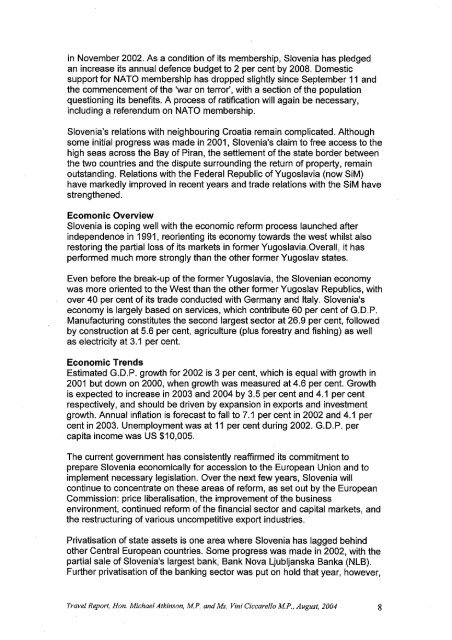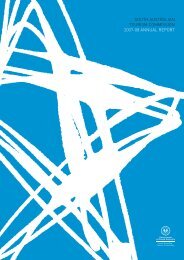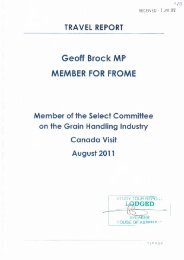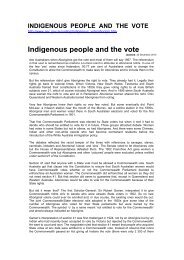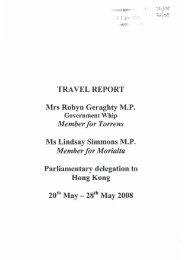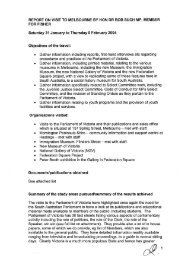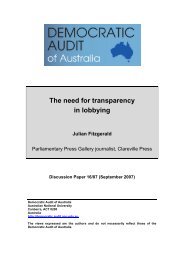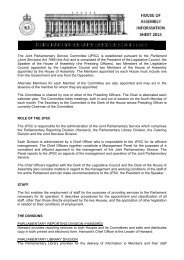TRAVEL REPORT The Hon. Michael Atkinson MP Attorney-General ...
TRAVEL REPORT The Hon. Michael Atkinson MP Attorney-General ...
TRAVEL REPORT The Hon. Michael Atkinson MP Attorney-General ...
You also want an ePaper? Increase the reach of your titles
YUMPU automatically turns print PDFs into web optimized ePapers that Google loves.
in November 2002 . As a condition of its membership, Slovenia has pledgedan increase its annual defence budget to 2 per cent by 2008 . Domesticsupport for NATO membership has dropped slightly since September 11 andthe commencement of the 'war on terror', with a section of the populationquestioning its benefits . A process of ratification will again be necessary,including a referendum on NATO membership .Slovenia's relations with neighbouring Croatia remain complicated . Althoughsome initial progress was made in 2001, Slovenia's claim to free access to thehigh seas across the Bay of Piran, the settlement of the state border betweenthe two countries and the dispute surrounding the return of property, remainoutstanding . Relations with the Federal Republic of Yugoslavia (now SiM)have markedly improved in recent years and trade relations with the SiM havestrengthened .Ecomonic OverviewSlovenia is coping well with the economic reform process launched afterindependence in 1991, reorienting its economy towards the west whilst alsorestoring the partial loss of its markets in former Yugoslavia . Overall, it hasperformed much more strongly than the other former Yugoslav states.Even before the break-up of the former Yugoslavia, the Slovenian economywas more oriented to the West than the other former Yugoslav Republics, withover 40 per cent of its trade conducted with Germany and Italy . Slovenia'seconomy is largely based on services, which contribute 60 per cent of G .D .P .Manufacturing constitutes the second largest sector at 26 .9 per cent, followedby construction at 5 .6 per cent, agriculture (plus forestry and fishing) as wellas electricity at 3 .1 per cent .Economic TrendsEstimated G.D .P . growth for 2002 is 3 per cent, which is equal with growth in2001 but down on 2000, when growth was measured at 4.6 per cent . Growthis expected to increase in 2003 and 2004 by 3 .5 per cent and 4 .1 per centrespectively, and should be driven by expansion in exports and investmentgrowth . Annual inflation is forecast to fall to 7 .1 per cent in 2002 and 4 .1 percent in 2003 . Unemployment was at 11 per cent during 2002 . G.D .P . pe rcapita income was US $10,005 .<strong>The</strong> current government has consistently reaffirmed its commitment toprepare Slovenia economically for accession to the European Union and toimplement necessary legislation . Over the next few years, Slovenia willcontinue to concentrate on these areas of reform, as set out by the EuropeanCommission : price liberalisation, the improvement of the businessenvironment, continued reform of the financial sector and capital markets, andthe restructuring of various uncompetitive export industries .Privatisation of state assets is one area where Slovenia has lagged behindother Central European countries . Some progress was made in 2002, with thepartial sale of Slovenia's largest bank, Bank Nova Ljubljanska Banka (NLB) .Further privatisation of the banking sector was put on hold that year, however,Travel Report, <strong>Hon</strong>. <strong>Michael</strong> <strong>Atkinson</strong>, <strong>MP</strong>. and Ms. Vini Ciccarello M.P ., August, 2004 8


